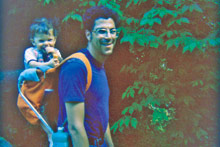My husband, Lenny, and I first visited Great Smoky Mountains National Park back in 1974. We were on a driving vacation from New Jersey and thought we could “do” both Shenandoah National Park and the Smokies in a mere two weeks. While I carried a pack filled with food, water and diapers, Lenny backpacked our 15-month-old up the Smokies’ Ramsey Cascades Trail, east of Gatlinburg, Tenn. We marveled at the huge hemlocks and the profusion of blooming red bee balm. Past the old Jeep road, the trail became rocky, wet and precarious, but we reached the cascades.

I live in Asheville now, my son’s all grown up, and I regularly hike in the park. But I still wonder how we all made it.
This year, Ramsey Cascades and several other Smokies trails are getting a major makeover, thanks to Smokies Trails Forever, a fundraising partnership between the park and the nonprofit Friends of the Smokies.
Although the Smokies is our most-visited national park, its funding falls short of meeting trail-maintenance needs. Last year, more than 9 million people visited the park, which has a budget of $18.2 million. That amounts to about $2 per visitor. What a bargain! In contrast, Dollywood charges adult visitors $53.50 and Walt Disney World $75 for a one-day ticket—and I don’t think either amusement park has any hiking trails to maintain.
In the 1930s, the Civilian Conservation Corps created most of the pathways and facilities we enjoy in the park today. As part of F.D.R.‘s New Deal initiatives, the Corps built fire towers, campgrounds, bridges, picnic areas and restrooms in the Smokies, which boasted more crews than any two other national parks combined. Thanks to those folks, the toughest Smokies trails switch back beautifully up a mountain, making them—mile for mile—easier to walk than those in the surrounding Pisgah National Forest.
But the federal program ended in 1942: Who’s looking after these trails now?
Trails don’t maintain themselves—people do. Volunteers maintain the Appalachian and the Mountains-to-Sea trails, but these linear routes are easy to reach from the road. Paths in the Smokies form a network, and it can be challenging to reach the interior routes for maintenance or improvements. You may have to trek several miles from your vehicle to the work site—hauling your tools as you go—do the job and then slog back. Trail maintenance isn’t just a walk in the woods.
Currently, the park has two full-time maintenance crews: one each in North Carolina and Tennessee. In addition, park volunteers can “adopt” a trail, but most volunteer-maintained trails lie along the park’s periphery.
To get at the more remote trails and tackle the tougher projects, Trails Forever’s endowment will help fund a third permanent maintenance crew while providing training and support for volunteers. In one of last year’s pilot projects, Ramsey Cascades got some much-needed attention. To get more such projects under way, the Aslan Foundation—a longtime (and frequent) Friends of the Smokies supporter—has issued a $2 million challenge grant. Friends aims to match it in the coming years. Organizers are also calling for donations and volunteers who want to roll their sleeves up and go to work the way the Civilian Conservation Corps did.
Most national parks charge an entrance fee—$20 per car at Yosemite, $25 per car for Yellowstone. Even Shenandoah National Park charges $15 per car. But you can still drive into the Smokies for free. Sure, the park could sell the naming rights to its trails. Ramsey Cascades could be changed to the Royal Crown Cola Trail. Instead, the Smokies depend on those who love the park and want to see its trails used and preserved for their children and grandchildren.
On the Ramsey Cascades Trail, a professional crew plus volunteers have been removing roots and rocks and improving drainage to prevent the severe erosion that has nearly ruined it. This summer, when my granddaughter comes to visit, I’ll take her on Ramsey. It will be smoother and less rocky than it was when her daddy was carried to the falls. But no one is going to carry her, because she’ll be 6, and she can hike.
For more information about Trails Forever, visit http://smokiestrailsforever.org. To volunteer, contact Jeremy Sweat at Jeremy_Sweat@nps.gov. For info about the Smokies 75th-anniversary events, visit www.greatsmokies75th.com.
[Hike leader and outdoors writer Danny Bernstein is the author of Hiking North Carolina’s Blue Ridge Heritage. She can be reached at danny@hikertohiker.com.]



There’s a new driving trail called the Sunny Side Trail that winds through Smoky Mountain backroads and Appalachian countryside. There is an article and link at http://www.smokymountainpost.com. Thanks!